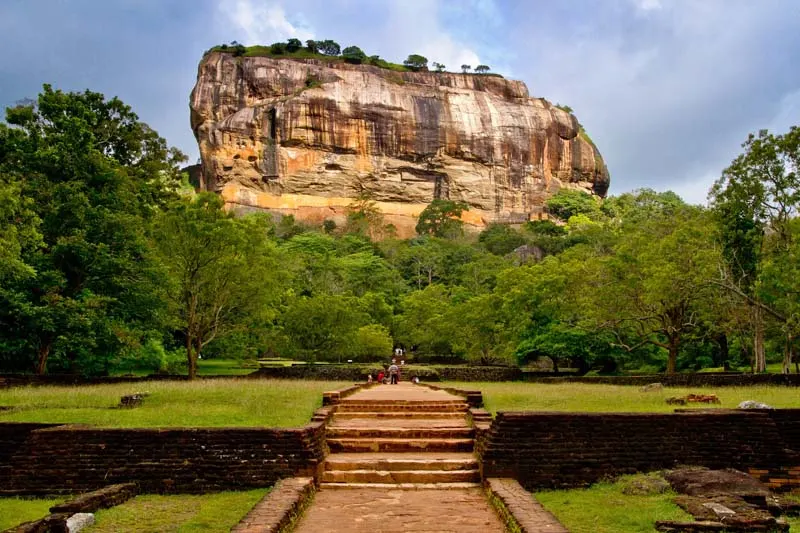Sigiriya, Lion Rock, is a unique harmony between nature and human imagination.
It is a best-preserved ancient rock fortress and one of the archeological treasures in South Asia. It’s a masterpiece of the ancient urban landscape with pools, architectural technology, exceptional hydraulic engineering and management, exquisite frescoes, graffiti, lion paws, a royal palace, moats, and ramparts of the fortification. Thus, UNESCO declared Sigiriya Rock Fortress as a World Heritage site.
Archeological excavations have revealed evidence of pre-historic human settlements dating back to the 4th century BC. In the 3rd century BC, the surrounding caves at Sigiriya served as a Buddhist monastery.
However, All the principal structures that are found today in Sigiriya, have been erected during the reign of King Kasyapa (A.D. 477 – 495), who created this massive rock as a fortification to protect himself from his brother. He built a palace on the summit of this granite peak standing 200m high from the surrounding plain. Approximately 1,200 steps are to be climbed to the summit.
After the king’s death, the Sigiriya became a Buddhist monastery until the 14th century. In the centuries that followed, Sigiriya was abandoned, until the 19th century.
Additional information
Things to Do
- Climbing
- Jeep Safari
- Birdwatching
- Village Walking
- Boating
- Hot Air Ballooning
Good for
- Ruins
- History
- Nature
- Relax
- Spa and Wellness
Nearby Attractions
- Sigiriya Sanctuary
The area with a 5099ha forest around the Sigiriya Rock Fortress rock is a preferred habitat of over 65 endemic, resident and migratory bird species. Thus, the area was declared as a Bird Sanctuary.
Several raptor species such as the Shaheen Falcon, White Bellied Sea Eagles, Grey-Headed Fish Eagle, Crested Serpent Eagle, and Crested Hawk-Eagle can be seen gliding over the area.
In addition, the thick canopied forest is home to a variety of both common and rare species such as the Little Scops Owl, Indian Long-tailed Night-Jar, Forest Eagle Owl, Openbill, Orange-breasted Green Pigeon, Green Imperial Pigeon, Emerald Dove, Ceylon Jungle Fowl, Orange-headed Ground Thrush, Indian Blue Chat, Brown-capped Babbler, White-Rumped Shama, Black-capped Bulbul, Tickell’s Blue Flycatcher, Brown Flycatcher, Layard’s Flycatcher, Orange Minivet, Small Minivet, Malabar Pied Hornbill, Ceylon Grey Hornbill, and Blue-faced Malkoha.
Distance: 500m
- Dambulla Rock Temple
Dambulla Cave Temple was a Buddhist monastery founded in the first century BC. The majority of the temple’s existing interior embellishments date from the 18th century. Today, it is the largest and best-preserved cave temple complex in Sri Lanka.
The 2100 square meters of the ceiling and walls are painted with life tales of Buddha, and there are 157 statues of Buddha, monks, gods, and kings in all.
Distance: 20 Km
- Minneriya National Park
Because of its elephant population, Minneriya National Park is the second most visited national park in Sri Lanka. From May through September, Asia’s largest elephant gathering takes place in their natural habitat. Ideal to visit in May to September.
Distance: 18.5 Km
- Kaudulla National Park
As an elephant corridor between Udawalawe and Somawathiya National Parks, Kaudulla National Park is essential to supporting the massive elephant gathering at Minneriya National Park. Ideal to visit in August to December.
Distance: 37 Km
- Namal Uyana Rose Quartz Mountain
Namal Uyana is a Buddhist Forest Monastery that was founded in the third century BC. The ruins of the ancient monastery can still be seen here.
The Rose Quartz Mountain is Asia’s largest Rose Quartz Mountain, surrounded by Ironwood (Mesua ferrea) forest. The seven-ridged mountain range rises from 180 to 300 meters above sea level. These rose quartz formations are around 550 million years old, and the region is Sri Lanka’s greatest plant fossil deposit.
The Ironwood Forest, which is several hundred years old, spans over 1000 hectares of land. The forest’s rather ordered structure shows that it was human cultivation.
Distance: 30.5 Km
- Ritigala Buddhist Monastery
Ritigala mountain range is a one-of-a-kind archaeological and ecological reserve. It contains a distinctive ecology rich in medicinal plants and rare fauna species.
The location with the 70 rock caves used to be a Buddhist monastic complex for hermit monks. The ruins cover an area of around 120 acres.
Distance: 35 Km
The most popular nearby attraction: Minneriya National Park (20 Km)
Accommodation
within 10 Km
Star Classified Hotels- Yes
Boutique Hotels- Yes
Resorts- Yes
International Chain Hotels- No
Ayurvedic Hotels- Yes
Villas- Yes
Eco Hotels- Yes
Camping- Yes
Unclassified Hotels- Yes
* You might still find preferred accommodation in nearby cities.
Distance
CMB Airport- 150 Km (travel time: 3hrs 30min)
Colombo City- 170 Km (travel time: 3hrs 50min)
Dambulla- 20 Km (travel time: 30min)
Anuradhapura Ancient City-74 Km (travel time: 1hrs 30min)
Polonnaruwa Ancient City- 53 Km (travel time: 1hrs 15min)
Kandy City- 90 Km (travel time: 2hrs 30min)
Galle Dutch Fort- 275 Km (travel time: 5hrs)
* The time and distance are only given to give you an idea. There are stopovers between the two locations. The cities listed above are some of the most popular tourist attractions in Sri Lanka.
Best Time
Year round

